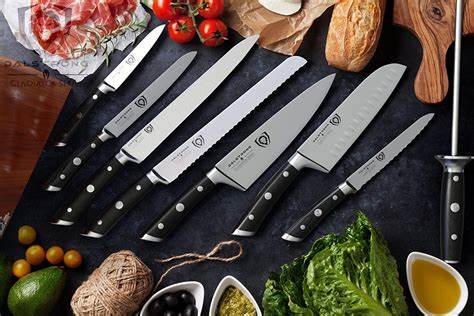Master Your Kitchen: A Complete Guide to the Essential Types of Knives and Their Uses

Choosing the right knife for the task at hand is essential for efficient cooking and food preparation. Each knife has a specific design that makes it ideal for certain cutting techniques or types of food. Whether you’re a seasoned chef or a home cook, understanding the various types of knives will help you elevate your kitchen skills. Here’s a guide to the most common types of kitchen knives and their uses:
1. Chef’s Knife (Cook’s Knife)
The chef’s knife is the most versatile and commonly used knife in the kitchen. It has a broad, curved blade, usually between 6 to 10 inches long, which allows for a rocking motion during chopping, slicing, and dicing.
Uses: Cutting vegetables, meat, herbs, and mincing garlic. It’s perfect for most general kitchen tasks.
2. Paring Knife
A paring knife is a small, sharp knife with a blade typically 3 to 4 inches long. It’s known for its maneuverability, allowing for intricate cuts and precise work.
Uses: Peeling, trimming, coring, and making small, detailed cuts. Great for fruits and vegetables like apples, strawberries, and potatoes.
3. Serrated Knife (Bread Knife)
A serrated knife has a long, toothed blade, similar to a saw, and is primarily used for cutting through foods with a hard exterior and soft interior.
Uses: Slicing bread, cakes, tomatoes, and other delicate or crusty foods. Its saw-like teeth make it perfect for slicing without crushing.
4. Santoku Knife
The Santoku knife is a Japanese multi-purpose knife with a shorter blade (typically 5 to 7 inches) and a slightly curved edge. The term “Santoku” translates to “three virtues” because it’s suitable for slicing, dicing, and mincing.
Uses: Perfect for chopping vegetables, fish, and meat. It’s ideal for those who prefer a lighter, more precise knife compared to a chef’s knife.
5. Boning Knife
A boning knife has a thin, flexible blade with a sharp point, typically 5 to 6 inches long. The narrow blade allows for precise cuts when removing bones from meat, poultry, and fish.
Uses: Deboning chicken, filleting fish, or removing fat and sinew from meat. Its flexibility allows for detailed work around bones.
6. Utility Knife
A utility knife is a medium-sized knife, typically between 4 to 7 inches long. It’s a good all-around knife that falls between the chef’s knife and paring knife in terms of size.
Uses: Slicing sandwiches, cutting fruits and vegetables, and performing small prep tasks that require more control than a chef’s knife.
7. Cleaver
A cleaver is a large, heavy knife with a thick, rectangular blade. It’s designed for cutting through bones, tough meat, and dense vegetables.
Uses: Chopping through bones, thick cuts of meat, and cutting through dense vegetables like squash or pumpkin.
8. Carving Knife
A carving knife has a long, slender blade (usually 8 to 14 inches) that tapers to a sharp point. This knife is designed for slicing thin, even cuts of meat, such as roasts, turkey, or ham.
Uses: Carving cooked meat, poultry, or fish into thin slices, and trimming large cuts of meat.
9. Fillet Knife
A fillet knife is similar to a boning knife but typically more flexible with a longer, narrower blade. The thin blade allows for precise, smooth cuts through fish and other delicate proteins.
Uses: Filleting fish, skinning fish, or cutting delicate pieces of meat with minimal waste.
10. Nakiri Knife
A Nakiri knife is a traditional Japanese knife with a rectangular blade and a straight edge. It’s designed for cutting vegetables and herbs with a precise and clean cut.
Uses: Chopping vegetables, dicing, and slicing. The flat edge allows for full contact with the cutting board for a smooth, even cut.
11. Tomato Knife
A tomato knife is a small, serrated knife with a thin blade, typically around 5 to 6 inches long. The serrated edge makes it easy to slice through the soft skin and flesh of tomatoes without crushing them.
Uses: Slicing tomatoes and other delicate fruits with soft skins, like peaches or pears.
12. Steak Knife
A steak knife is a serrated knife designed specifically for cutting through cooked meat, especially steak. The sharp, pointed blade makes it easy to cut through meat without tearing it.
Uses: Cutting steak or other meats at the dining table. It is often part of a place setting for formal dinners.
13. Peeling Knife
A peeling knife is a small, curved knife with a short, sharp blade, typically around 2 to 3 inches. It’s designed specifically for peeling fruits and vegetables.
Uses: Peeling thin-skinned fruits and vegetables, such as apples, oranges, or potatoes, where precision is key.
14. Mincing Knife (Mezzaluna)
A mincing knife or mezzaluna features a curved blade and is typically used for chopping herbs or garlic. The blade is rocked back and forth to mince ingredients finely.
Uses: Mincing herbs, garlic, or small vegetables. The rocking motion makes it easier to chop finely and evenly.
15. Chisel Knife
A chisel knife has a wide, flat blade, similar to a chisel used in woodworking. It’s not as commonly used as other knives but can be useful for precision tasks in the kitchen.
Uses: Scraping or cutting through thicker food items or making detailed cuts for presentation.
Conclusion
Each knife in your kitchen has a specific purpose, and knowing how to use them effectively can improve both the efficiency and quality of your cooking. Whether you’re chopping vegetables, carving a roast, or filleting fish, selecting the right knife for the job ensures the best results and helps prevent accidents. Investing in a good-quality set of knives tailored to your needs will make meal prep easier and more enjoyable.
